Looking for a fast-growing groundcover to naturally suppress weeds and protect your soil from the elements, too? Well, look no further because we have the best and most vigorous growing groundcovers right here. Say goodbye to dandelions, crabgrass, and other unwanted plants, and say hello to stunningly colored and easy-going groundcovers for backyards, gardens, flower bed borders, and so much more!
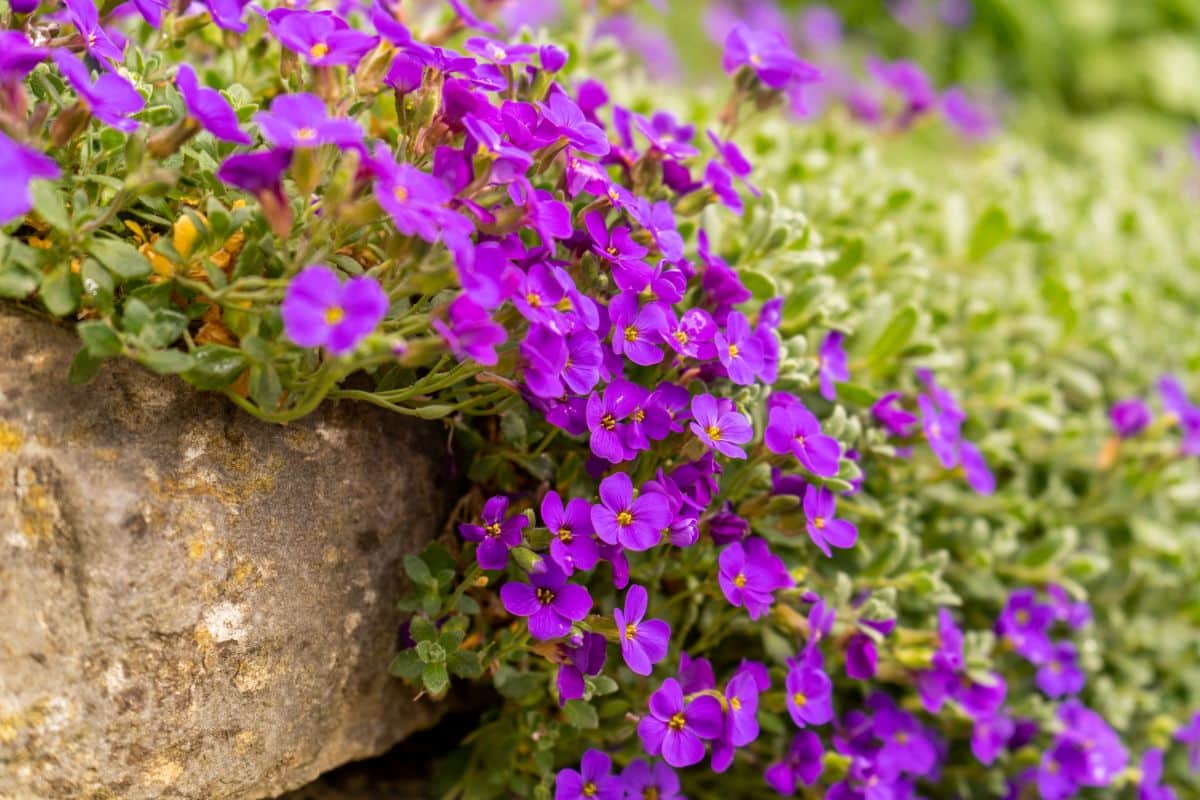
Jump to:
- 18 fast-growing groundcovers that keep weeds in check
- 1. Deadnettle (Lamium spp.)
- 2. Bugleweed (Ajuga reptans)
- 3. Sweet woodruff (Galium odoratum)
- 4. Strawberries (Fragaria × ananassa)
- 5. Mint (Mentha spp.)
- 6. Rockcress (Aubretia spp.)
- 7. Geraniums (Geranium sanguineum)
- 8. Japanese pachysandra (Pachysandra terminalis)
- 9. Yellow archangel (Lamium galeobdolon)
- 10. Golden star (Chrysogonum virginianum)
- 11. Bunchberry (Cornus canadensis)
- 12. Creeping phlox (Phlox stolonifera)
- 13. Snow on the mountain (Euphorbia marginata)
- 14. Creeping Jenny (Lysimachia nummularia)
- 15. Creeping periwinkle (Vinca minor)
- 16. Sedum (Sedum spp.)
- 17. Ice plant (Delospermaspp., Lampranthusspp.)
- 18. Wintercreeper (Euonymus fortunei)
- Summary
18 fast-growing groundcovers that keep weeds in check
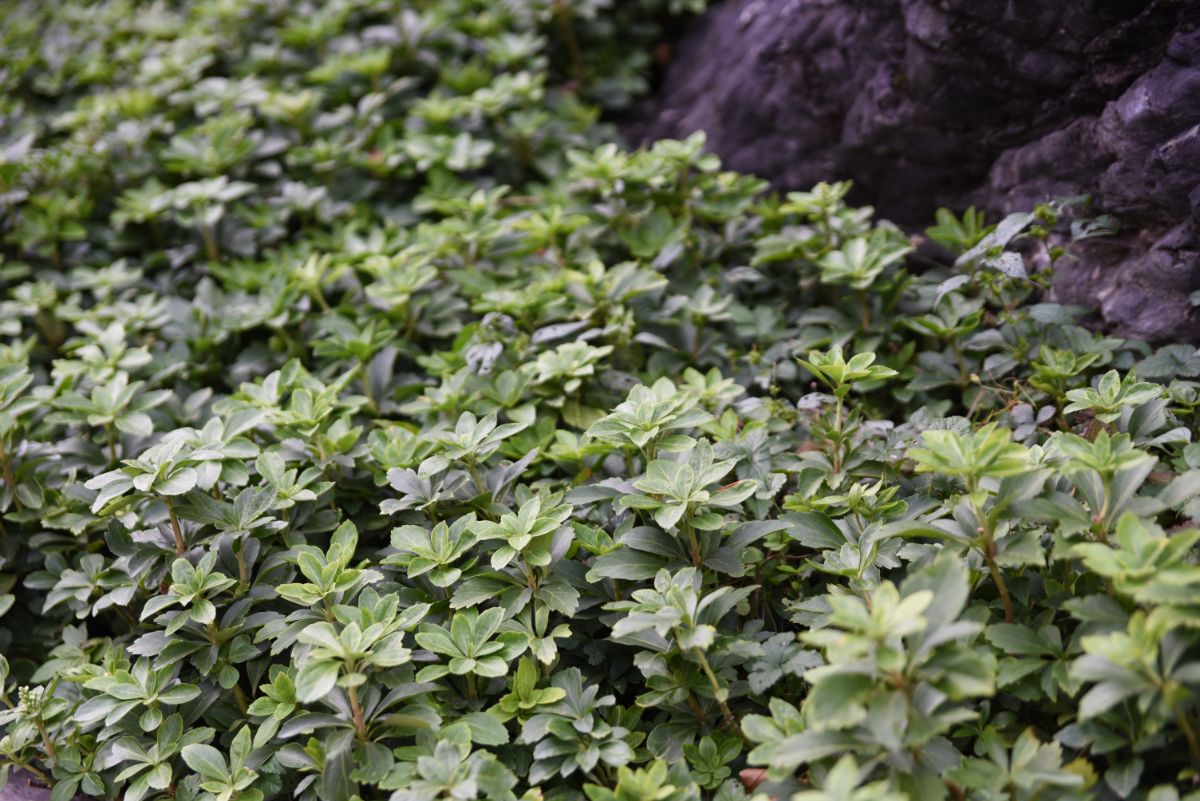
Groundcovers offer lots of benefits to the garden. Not only do they suppress weeds, but they can serve as buffers against rain and snow and help to maintain soil quality, too.
Below, you’ll find some of the easiest-to-grow groundcovers around. Just keep in mind that some of these fast-growing plants can be invasive in some areas, so you will want to take care when growing them and prune them back as needed. After all, you don’t need your groundcovers to become weedy nuisances, too!
1. Deadnettle (Lamium spp.)
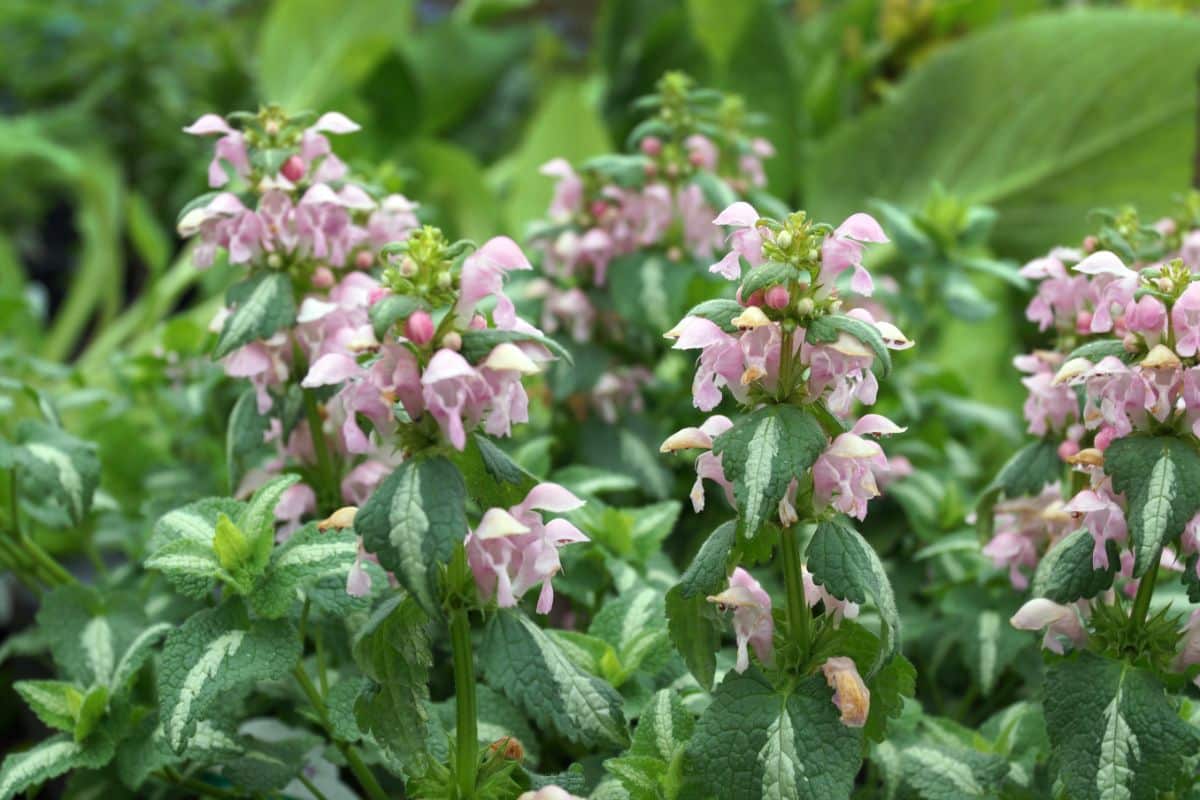
| Plant name: | Deadnettle |
| Light needs: | Full sun to part shade |
| Water needs: | Moderate to low |
| Growing zone: | Zones 3 to 8 |
| Special features: | Edible; Pollinator favorite |
Deadnettle is a reliable grower, and it can spread rapidly by its underground root runners. In some areas, deadnettle can grow invasively, but you can keep plants in check by keeping them in raised beds and pruning them often. However, while deadnettle can get a bit wild at times, that wildness is what makes this plant so good at suppressing weed.
There are several types of deadnettle that are commonly sold at stores, including purple deadnettle and spotted deadnettle. Some types of deadnettle are edible, and they have a slightly minty flavor, which is no surprise as deadnettles belong to the mint family! Some types of deadnettles have green leaves, while others sport variegated foliage, but these plants also produce purple or white flowers that are highly attractive to bees!
2. Bugleweed (Ajuga reptans)
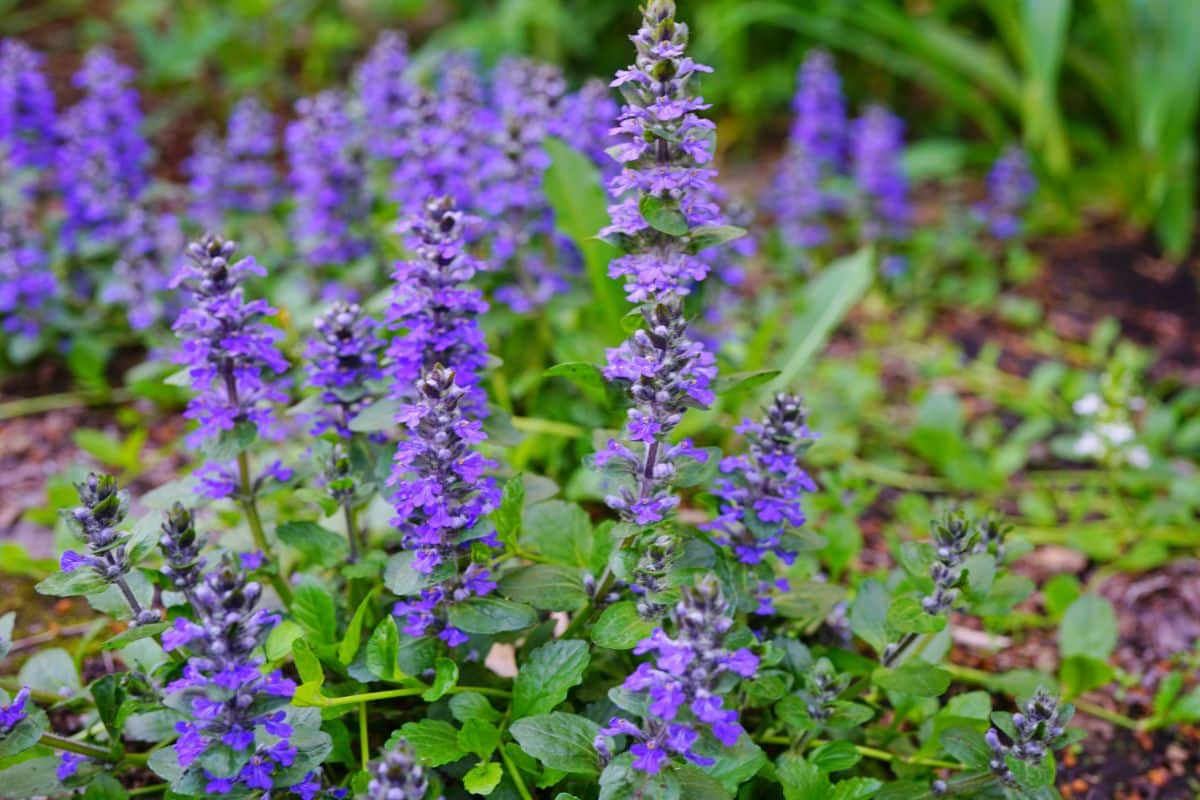
| Plant name: | Bugleweed |
| Light needs: | Full sun to shade |
| Water needs: | Moderate |
| Growing zone: | Zones 3 to 9 |
| Special features: | Good for shade gardens |
An excellent choice for shade gardens, bugleweed is another fast spreader, and, at first, it can look quite similar to deadnettle. Like deadnettle, bugleweed forms a thick mat of leaves as it grows, which can help suppress many different weed species. But this plant has dark, copper to purple colored leaves that are quite unique and tall, blue flowers that appear from spring to summer.
In some areas, bugleweed can grow invasively, but otherwise, bugleweed plants are quite easy to keep. Bugleweed is another member of the mint family, and parts of the plant are also edible, although many foragers steer clear of bugleweed because it has a bitter flavor. A single bugleweed plant will typically spread over 18” of earth, while plant stems usually max out at around 6” tall.
3. Sweet woodruff (Galium odoratum)
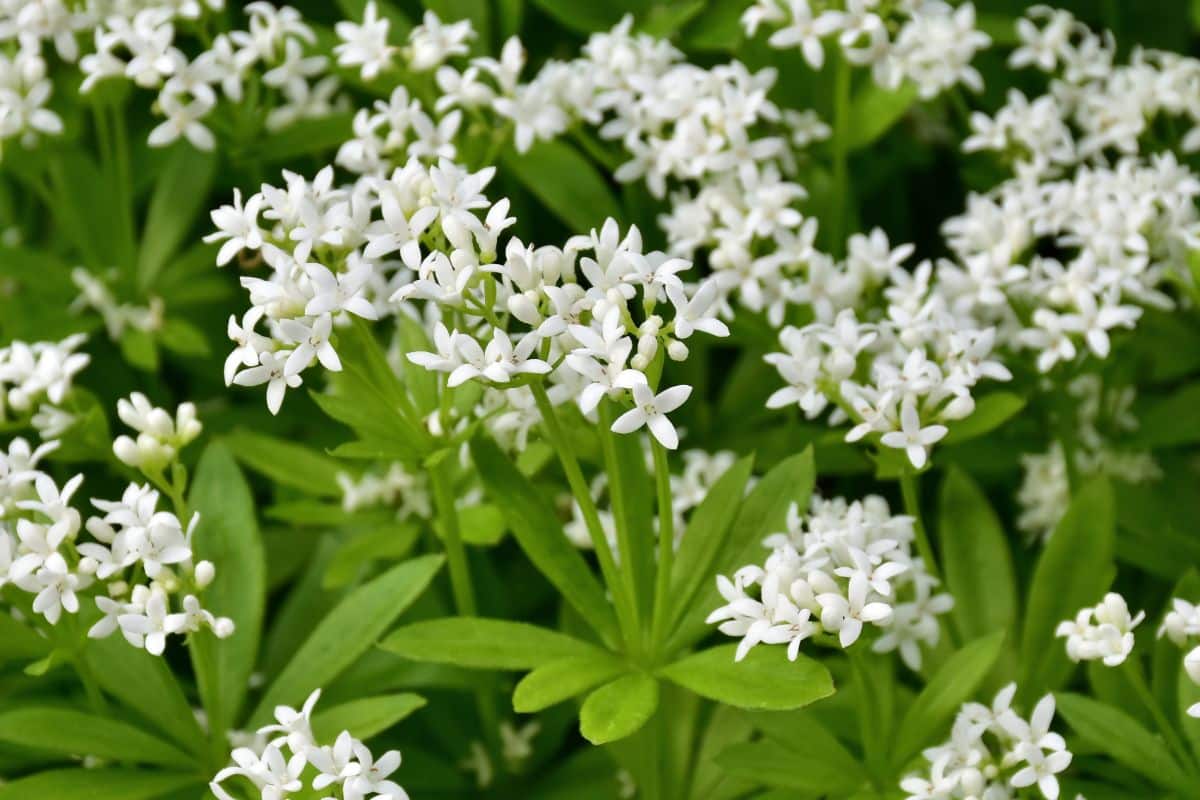
| Plant name: | Sweet woodruff |
| Light needs: | Part shade to full shade |
| Water needs: | Moderate to low |
| Growing zone: | Zones 4 to 8 |
| Special features: | Fragrant; Good for shade gardens |
Also known as sweet-scented bedstraw, sweet woodruff is a darling of a plant that adds a touch of class to woodland gardens, but it can be grown in other shady landscapes, too. In ideal conditions, sweet woodruff can spread aggressively, but this is less likely to occur when plants are kept in drier soil types. Aside from its whorled leaves, sweet woodruff plants produce fine, star-shaped, white flowers in spring to early summer, which emit a sweet, vanilla-like fragrance.
Sweet woodruff can be grown in large clusters or drifts of plants, or you can use sweet woodruff in mixed planting arrangements along with other shade-loving beauties. When properly maintained, sweet woodruff plants can spread up to 18” per year, and plants generally grow to about 8” tall. If your garden gets a fair amount of shade, you may want to try sweet woodruff with other shade-tolerant ornamentals, like false indigo and yarrow.
4. Strawberries (Fragaria × ananassa)

| Plant name: | Strawberries |
| Light needs: | Full sun |
| Water needs: | Moderate |
| Growing zone: | Zones 5 to 10 |
| Special features: | Edible |
Most gardeners think of strawberries simply as edible plants, but happy strawberries can grow impressively fast, and they can choke out weeds, too! Day-neutral strawberries are typically grown as annuals, but June-bearing strawberries return year after year, and they produce lots of strawberry runners that can be propagated into new plants. And if you’re tired of strawberries, there are other options as well, such as white strawberries and pink strawberries!
Strawberry plants can be purchased at nursery centers, but if you’re lucky, you may already have wild strawberries growing on your property. Just keep in mind that these plants need lots of sun to support their berry growth. And birds and other critters love eating strawberries, too, so you may want to keep your plants covered with floating row covers if you’re worried about animals eating your strawberries before you get a chance!
5. Mint (Mentha spp.)
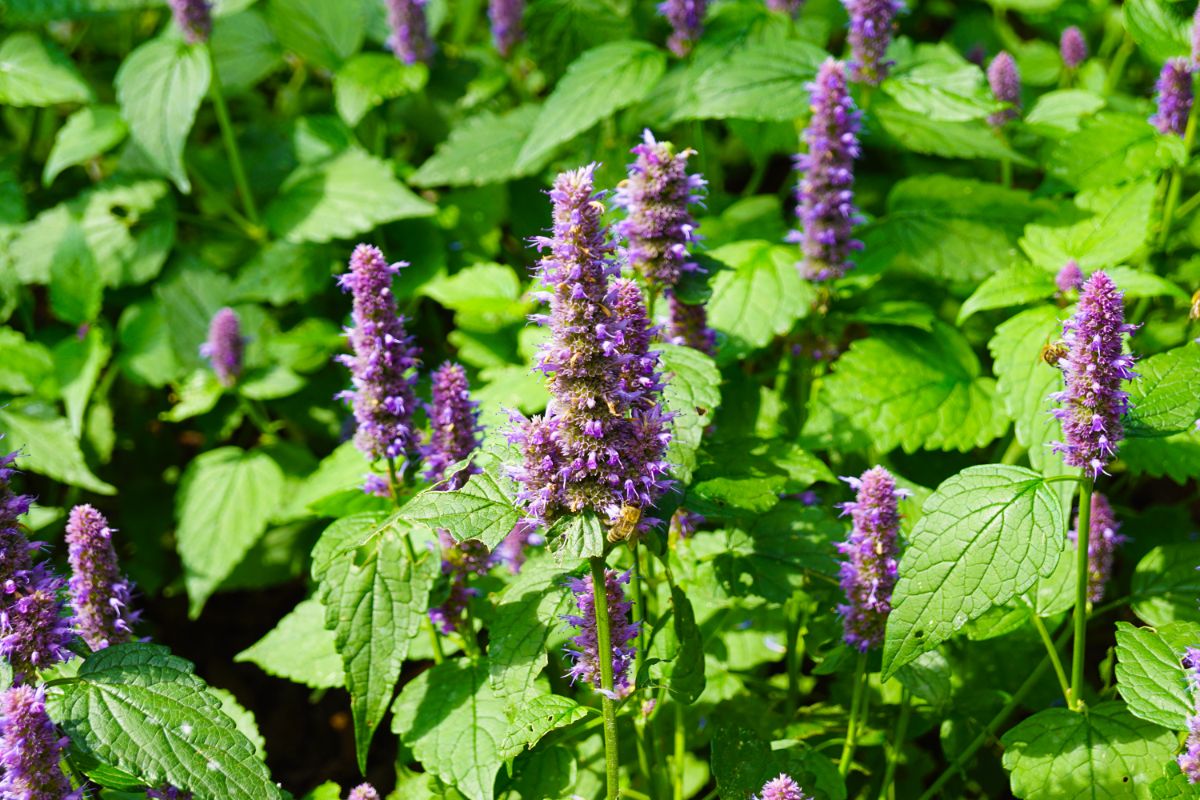
| Plant name: | Mint |
| Light needs: | Full sun to part shade |
| Water needs: | Moderate |
| Growing zone: | Zones 3 to 10 |
| Special features: | Edible; Pollinator favorite |
Another edible plant option, mint, is rather notorious for its fast-growth habit, and it can quickly overwhelm lower and slower-growing plants. But if you’re struggling with weeds, mint’s fast growth habit can be a boon, and mint plants have other benefits, too. Of course, most of us are well aware that mint produces delicious, edible leaves, but mint flowers are also highly attractive to pollinators, and the plant emits a heady fragrance when it's crushed underfoot or mowed with a lawnmower.
Many types of mint can be grown as groundcovers, but Corsican mint is a particularly fun option. This plant has smaller leaves than many other mint species, which makes it a fine pick for fairy gardens and for growing around garden walkways and paths. As they grow, mint plants spread via underground runners, as well as seeds, so if you ever need to remove mint plants, you’ll want to tackle their root system first and pinch off flowers so they don’t go to seed.
6. Rockcress (Aubretia spp.)
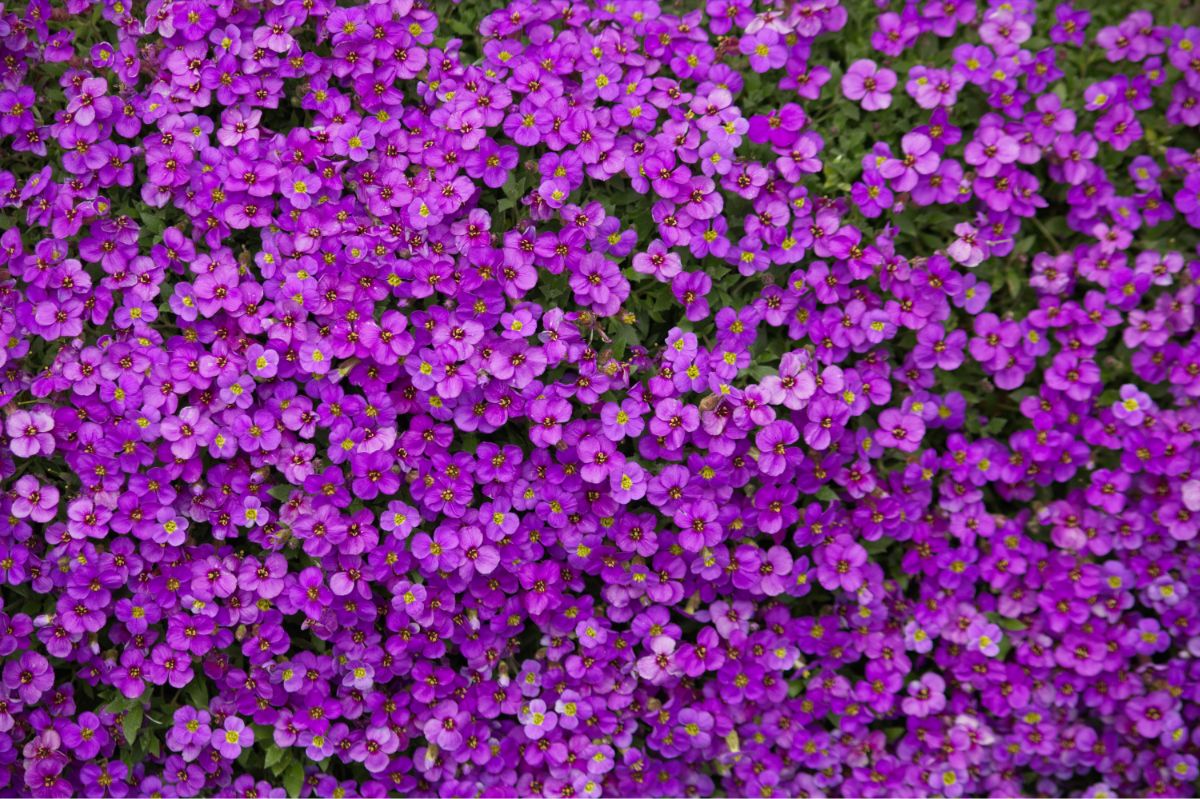
| Plant name: | Rockcress |
| Light needs: | Full sun to part shade |
| Water needs: | Moderate |
| Growing zone: | Zones 4 to 9 |
| Special features: | Good for hot and sunny spaces; Can trail over retaining walls; Showy flowers |
A top choice for sunny gardens, rockcress can handle the heat, and it’s a fast-growing plant that spreads over 12” wide. While rockcress can definitely choke out weeds, this plant is mostly known for producing a thick carpet of purple to pink flowers in summer. Some gardeners grow rockcress near retaining walls and allow the plant’s natural growth habit to cascade over the wall face; however, rockcress also looks stunning when used as a groundcover or border plant.
Rockcress can sometimes be plagued by slugs and snails, so you will want to keep an eye out for these pests, and you may want to install slug pubs to protect your rockcress. But while these plants are appealing to some insects, deer tend to leave rockcress alone, and butterflies and bees flock to these plants when they’re in flower. Unlike some other plants on this list, rockcress is not known for having invasive qualities, but plants will grow better if you prune them back slightly after they’re finished flowering.
7. Geraniums (Geranium sanguineum)
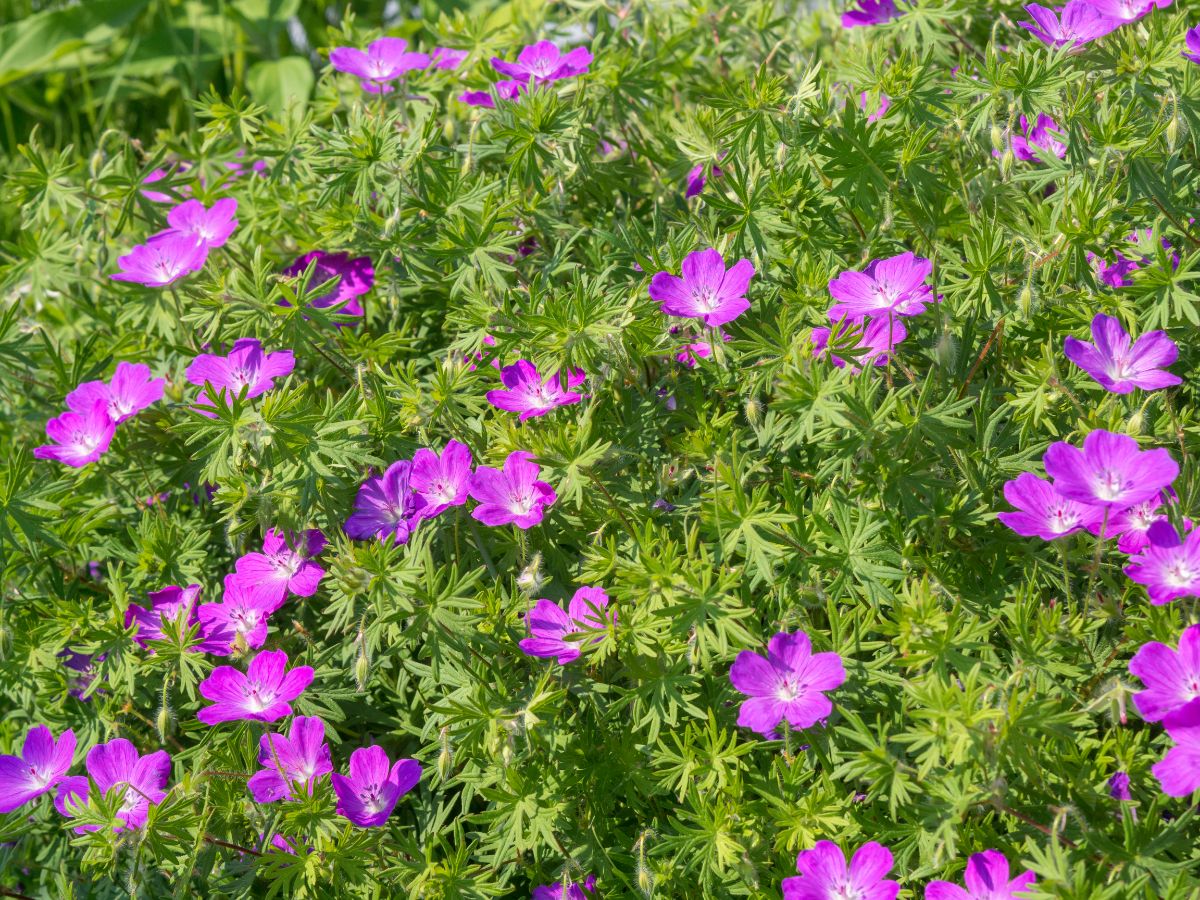
| Plant name: | Geraniums |
| Light needs: | Full sun to part shade |
| Water needs: | Moderate |
| Growing zone: | Zones 4 to 8 |
| Special features: | Showy flowers; Pollinator favorite |
There are many types of geranium plants that can be grown as ornamentals, but if you’re on the hunt for weed-suppressing groundcovers, one of the best options is Geranium sanguineum or bloody cranesbill. As they grow, bloody cranesbill geraniums produce soft mounds of foliage, and their leaves are deeply cut, which gives the plant plenty of texture, too. But while there are lots of features to recommend this plant, bloody cranesbill is mostly prized for its summer-blooming flowers, which come in shades of pink or white.
Once established, bloody cranesbill is an undemanding plant, and it has a good deal of drought tolerance, too. Individual plants can spread over 24” wide by 18” tall, and if you plant several plants together, you can smother out tons of pesky weeds. And if you need even more reasons to love bloody cranesbill plants, this geranium species is a magnet for pollinators as well!
8. Japanese pachysandra (Pachysandra terminalis)

| Plant name: | Japanese pachysandra |
| Light needs: | Part shade to full shade |
| Water needs: | Moderate |
| Growing zone: | Zones 4 to 9 |
| Special features: | Deer resistant; Good for shade gardens; Evergreen leaves |
One of the most classic groundcovers around, Japanese pachysandra might as well be called “old faithful” because it will grow in so many different conditions and rarely causes any fuss. Unlike many other groundcovers, Japanese pachysandra’s deep green, leathery leaves stay evergreen through the winter months, which means you can keep your garden colorful year-round if you keep this groundcover. But even better, Japanese pachysandra produces small, white flowers in spring, which only add to its allure.
Although this plant is a fast grower and can sometimes spread beyond garden borders, it doesn’t have the invasiveness of some other groundcovers. Mature plants grow to about 6” tall, and plants spread and form colonies quickly via their underground runners or rhizomes. Another fine selection for shady spaces, Japanese pachysandra thrives in moist but not overly soggy soil, and it needs minimal fertilizer, too.
9. Yellow archangel (Lamium galeobdolon)
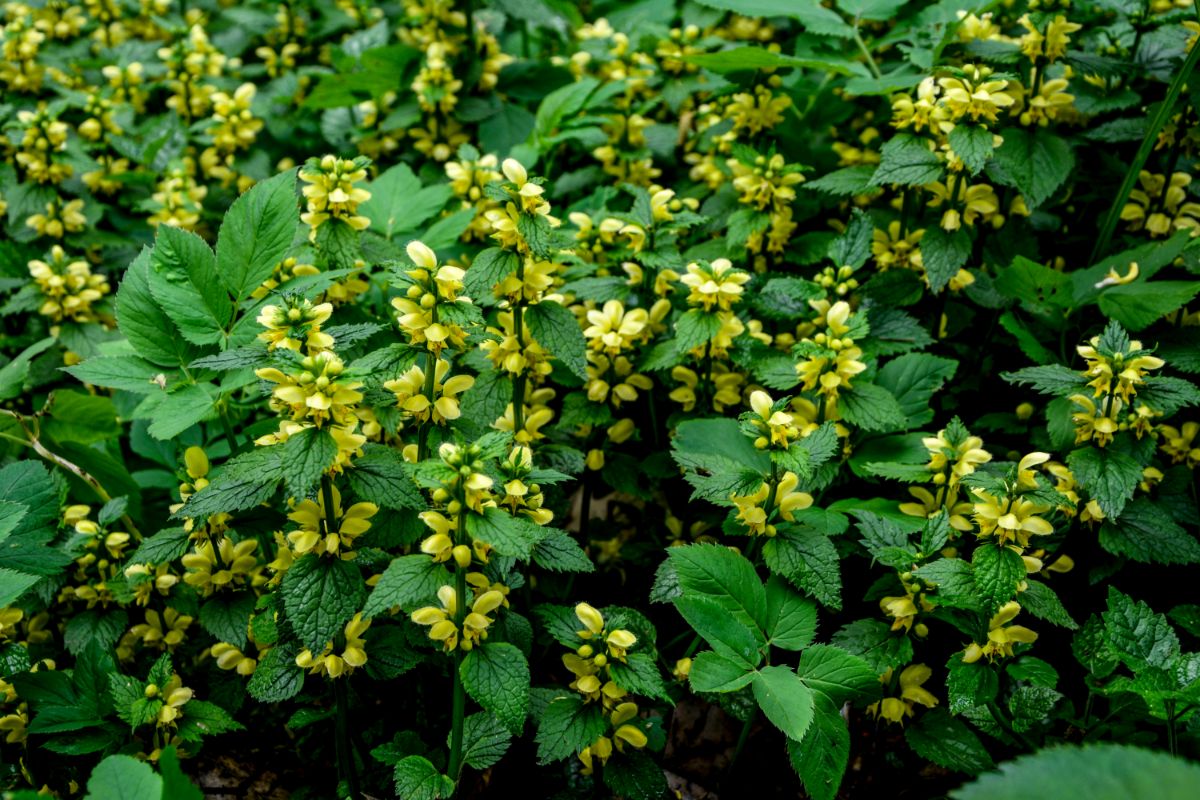
| Plant name: | Yellow archangel |
| Light needs: | Part shade to full shade |
| Water needs: | Moderate |
| Growing zone: | Zones 4 to 9 |
| Special features: | Edible; Attracts bumblebees |
Yellow archangel is actually a type of deadnettle, but this plant has bright, sunny yellow flowers that make it stand out in gardens. Like deadnettles, yellow archangel plants can have green or variegated leaves, and some varieties even produce leaves with flashy purple undersides. However, like deadnettles, yellow archangel can grow invasively in some areas, so it should be handled with care.
Archangel flowers typically bloom in spring, and they are irresistible to many types of pollinators, but especially to bumblebees. These plants can tolerate most types of soil, including slightly acidic conditions, and they can quickly grow over 2’ tall and 2’ wide. Like other members of the mint family, yellow archangel leaves emit a minty fragrance when crushed, and the leaves and flowers of the plant are edible, too!
10. Golden star (Chrysogonum virginianum)
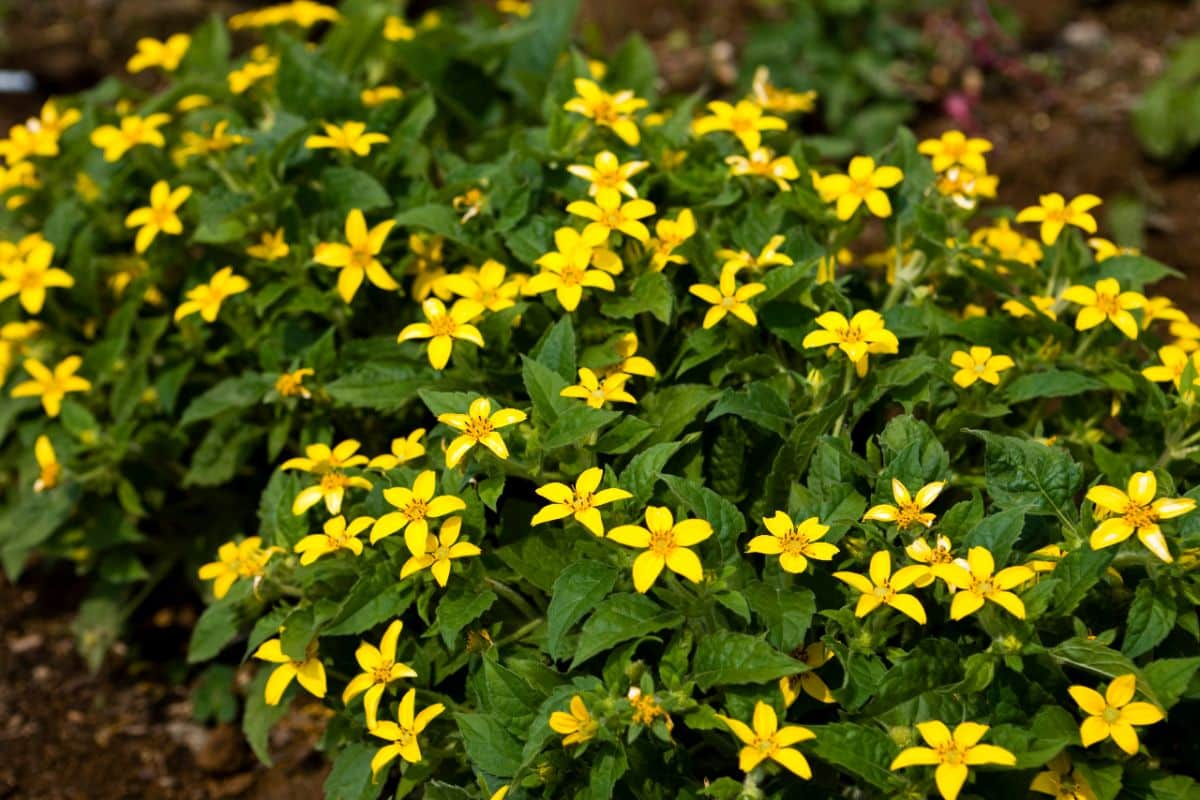
| Plant name: | Golden star |
| Light needs: | Full sun to part shade |
| Water needs: | Moderate |
| Growing zone: | Zones 5 to 9 |
| Special features: | Native to North America; Attracts pollinators, including butterflies |
If you’re worried about fast-growing groundcovers taking over your garden, golden star plants may be the solution you’ve been looking for. These plants are native to North America, so they aren’t considered invasive. But even better, golden star plants support native pollinators, including several species of butterflies.
Most growers keep golden star plants for their dainty yellow flowers, which can bloom from spring through fall. In some areas, golden star plants can remain evergreen throughout the winter, and they can tolerate shadier conditions than many other plants. Because golden star grows quickly, some gardeners trim back and divide their plants every few years, but if your goal is weed suppression, you may want to let your golden star plants grow as they please.
11. Bunchberry (Cornus canadensis)
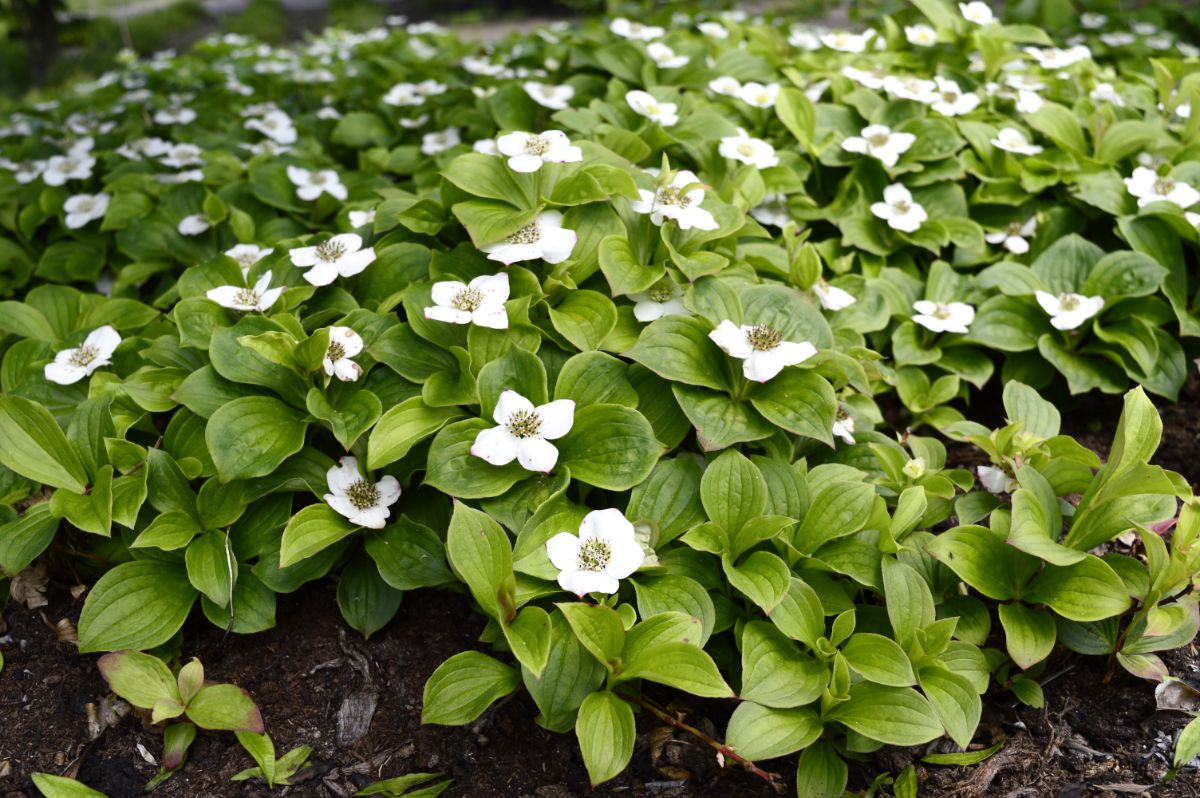
| Plant name: | Bunchberry |
| Light needs: | Full sun to part shade |
| Water needs: | High to moderate |
| Growing zone: | Zones 2 to 7 |
| Special features: | Ultra-cold hardy; Native to North America; Attracts pollinators; Autumn color |
Bunchberry is another North American native, and though it grows quickly, this plant is not known to be invasive. Bunchberry plants can tolerate both shade and sun, and they are ultra-cold hardy, overwintering with ease in areas as cool as USDA growing zone 2. Interestingly, bunchberry is usually classified as a type of dogwood, and like its larger cousin, bunchberry plants yield season-long interest and an ever-changing display of color and texture.
In spring, bunchberry produces bright white flowers, which lure in an assortment of insects, including bees and beetles. By early fall, bunchberry flowers will have matured into bright red berries that wild birds can’t resist. And then, when temperatures drop, bunchberry leaves burn a brilliant red color that can liven up even the drabbest garden landscape!
12. Creeping phlox (Phlox stolonifera)
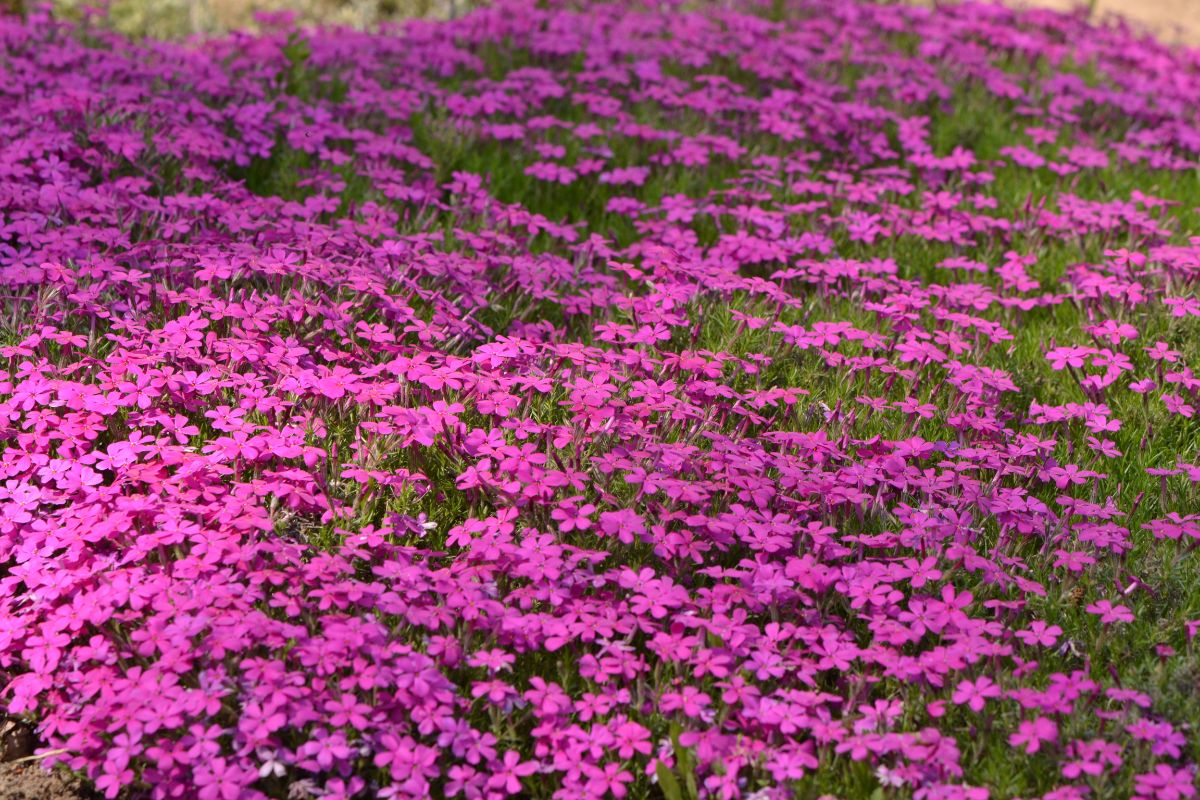
| Plant name: | Creeping phlox |
| Light needs: | Full sun to part shade |
| Water needs: | Moderate |
| Growing zone: | Zones 3 to 9 |
| Special features: | Colorful blooms; Pollinator favorite |
While bunchberry plants are the showiest in fall, creeping phlox comes alive in spring. This springtime bloomer flowers profusely from April to May, and it produces a sea of pink or white flowers that are so thickly distributed you can hardly see the plant’s leaves. After flowering, creeping phlox looks a bit more muted, but it remains a fantastic weed-suppressing groundcover!
Creeping phlox plants can grow about 1” per month in ideal conditions, and they take about 2 to reach their mature size of 6” high by 2’ wide. An excellent choice for hillsides, creeping phlox flowers will show best when they’re grown on an incline, but they can also be used in container gardens. Like many other plants on this list, creeping phlox is a great lure for pollinators, but plants don’t emit much of a fragrance.
13. Snow on the mountain (Euphorbia marginata)
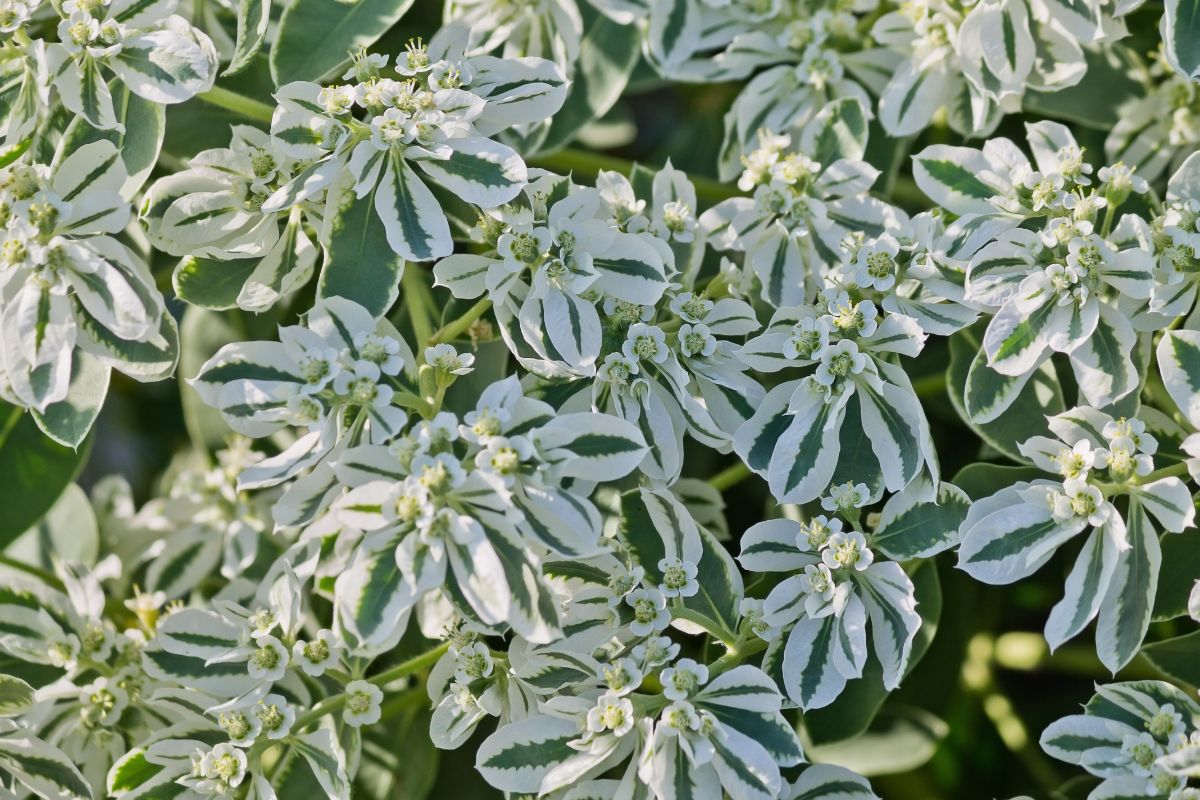
| Plant name: | Snow on the mountain |
| Light needs: | Full sun, can benefit from part shade in hot areas |
| Water needs: | Moderate |
| Growing zone: | Zones 3 to 9 |
| Special features: | Great for shade gardens |
Many plants don’t grow well in shade, and unplanted, shady garden sections can be prime real estate for weeds that tolerate low light. But if you want to keep weeds from creeping into your shady plot, you can try out snow on the mountain, which is a fast-growing groundcover that thrives in the shade. Also known as goutweed or bishop’s weed, snow on the mountain can tolerate full shade or part shade, and it can even grow happily in almost any soil type, as long as that soil drains well.
Snow on the mountain comes in both solid green and variegated options. The variegated version of this plant is particularly eye-catching, and its brilliantly white leaves can brighten up dark corners of your garden. On top of that, snow on the mountain has a shallow root system that won’t interfere with most other plant or tree roots, although this plant is still considered to be invasive in some areas.
14. Creeping Jenny (Lysimachia nummularia)
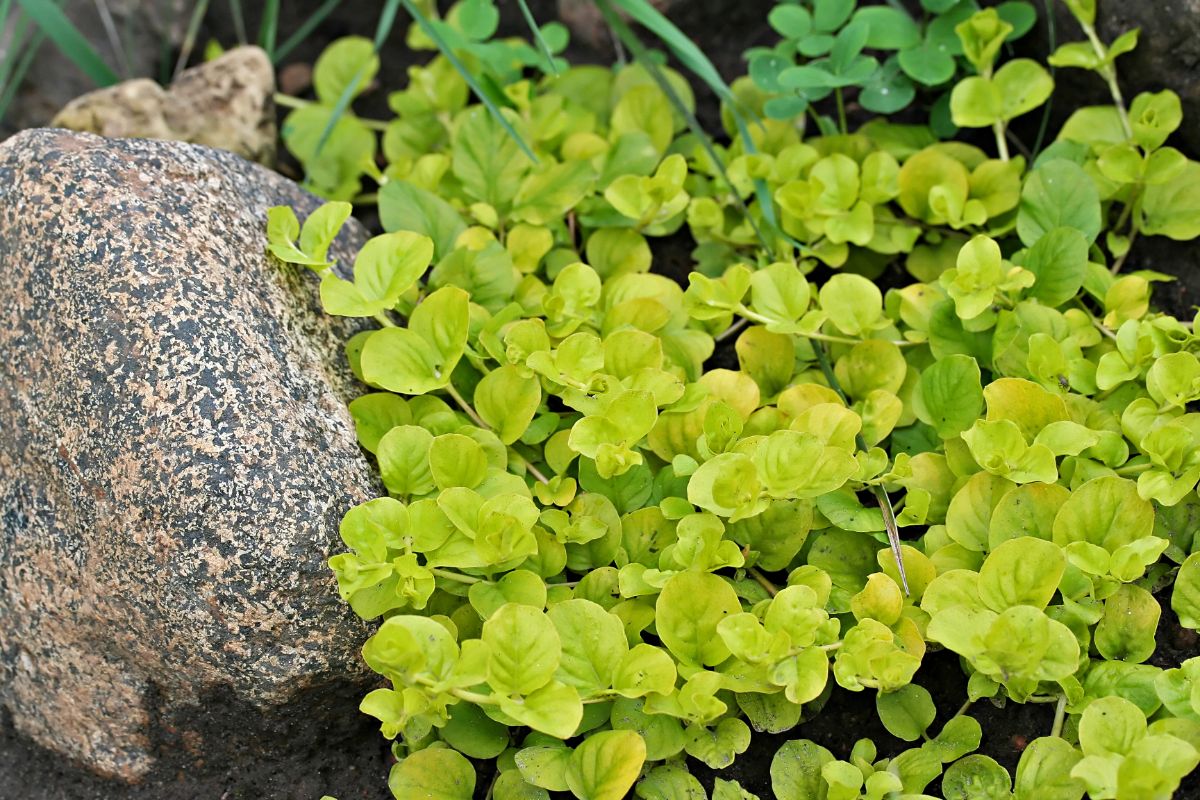
| Plant name: | Creeping Jenny |
| Light needs: | Full sun to part shade |
| Water needs: | High |
| Growing zone: | Zones 3 to 9 |
| Special features: | Good for boggy areas |
Lots of groundcovers grow well in dry areas, and they’re prime candidates for sandy gardens and sloping hillsides that drain well but are prone to erosion. However, if you’re looking for a groundcover to keep in soggy earth, creeping Jenny may be the solution. This adaptable plant is sometimes grown in water gardens, and it can even thrive in up to 1” deep water, so you know creeping Jenny won’t mind if you have a poorly draining garden.
Creeping Jenny is mostly known for its long and trailing stems that are covered in bright, chartreuse green leaves. In fact, this plant’s leaves are so becoming that it’s often grown in ornamental planters and window boxes as a “spiller” plant. But when creeping Jenny plants are mature, they also produce dainty, yellow, buttercup-like flowers that bloom from early summer to fall.
15. Creeping periwinkle (Vinca minor)
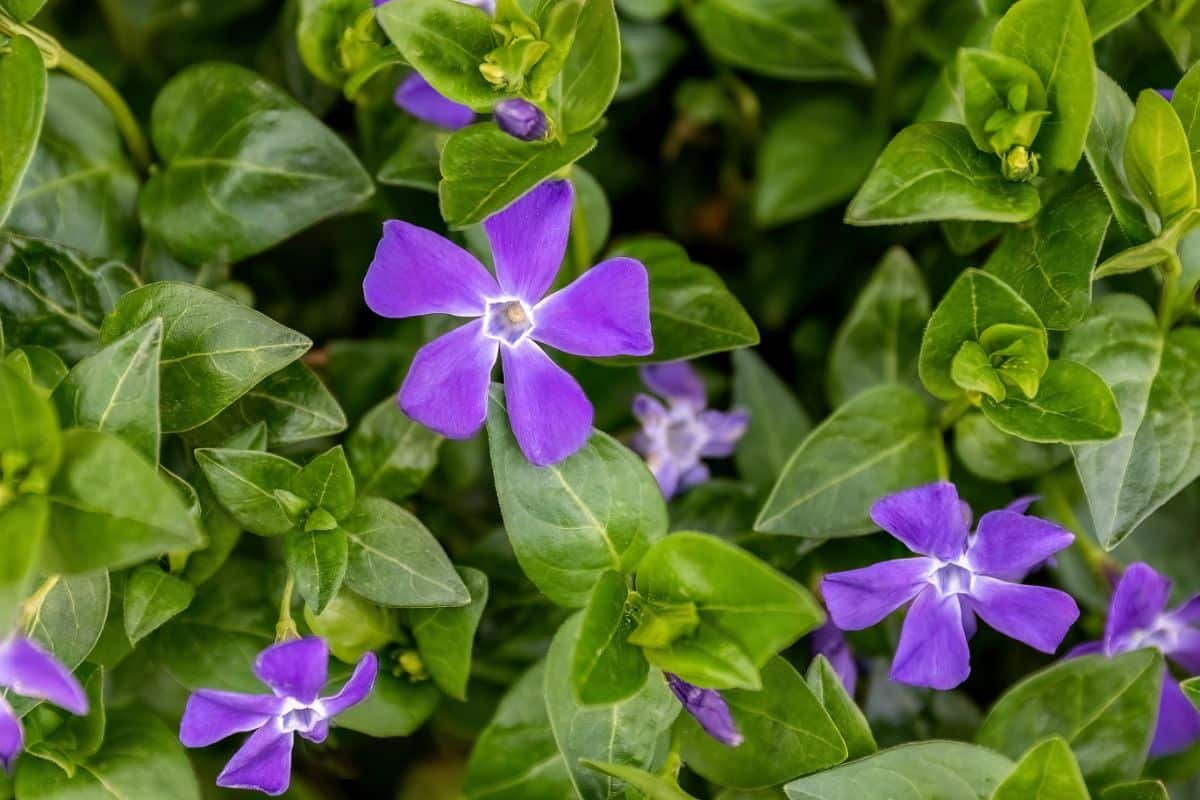
| Plant name: | Creeping periwinkle |
| Light needs: | Full sun to full shade |
| Water needs: | Moderate to low |
| Growing zone: | Zones 4 to 8 |
| Special features: | Tolerates most soils |
Also known as Vinca, creeping periwinkle is an extremely popular groundcover because it’s just so easy to keep. Creeping periwinkle can grow in gardens that are sunny or shady, and it’s a great choice for sloping hillsides and rock gardens as well. Like snow on the mountain, creeping periwinkle can handle just about any soil type, and it can even grow in gardens with sandy or clay-rich soils.
Year-round, creeping periwinkle keeps its broad and glossy, evergreen leaves. But this plant becomes even more colorful in spring when it bursts forth with a profusion of purplish-blue blooms. At times, periwinkle plants can even flower in summer, although they won’t bloom as abundantly as it does in spring.
16. Sedum (Sedum spp.)
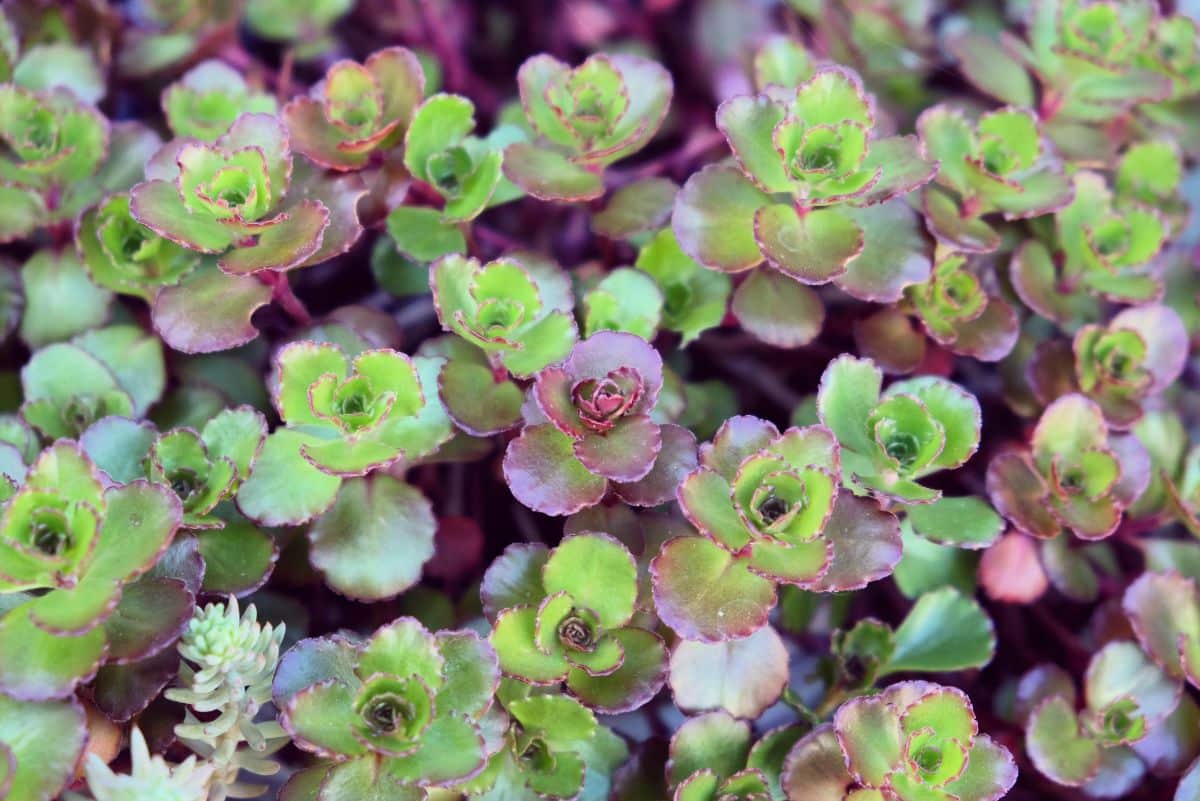
| Plant name: | Sedum |
| Light needs: | Full sun |
| Water needs: | Low |
| Growing zone: | Zones 3 to 11 |
| Special features: | Low water needs; Late season flowers |
Sedum plants are a fixture in ornamental gardens for a good reason. These resilient, succulent plants have ultra-low watering needs, and they can bounce back after drought with ease. Tall sedums, like ‘Autumn Joy,’ also put on a spectacular display of color in autumn, and their flowers are some of the last food sources for pollinators before winter arrives.
But although tall sedum plants have their charms, if you’re looking for a fast-growing groundcover to control weeds, you’ll want to look for low-growing sedum types. Cultivars like ‘Blue Spruce’ sedum, ‘Angelina’ sedum, and ‘Murale’ sedum don’t grow over 6” tall, but they have all of the beauty we’ve come to expect from larger sedum types. These small sedums also flower well, and many types of sedum can tolerate both sun and part shade.
17. Ice plant (Delospermaspp., Lampranthusspp.)
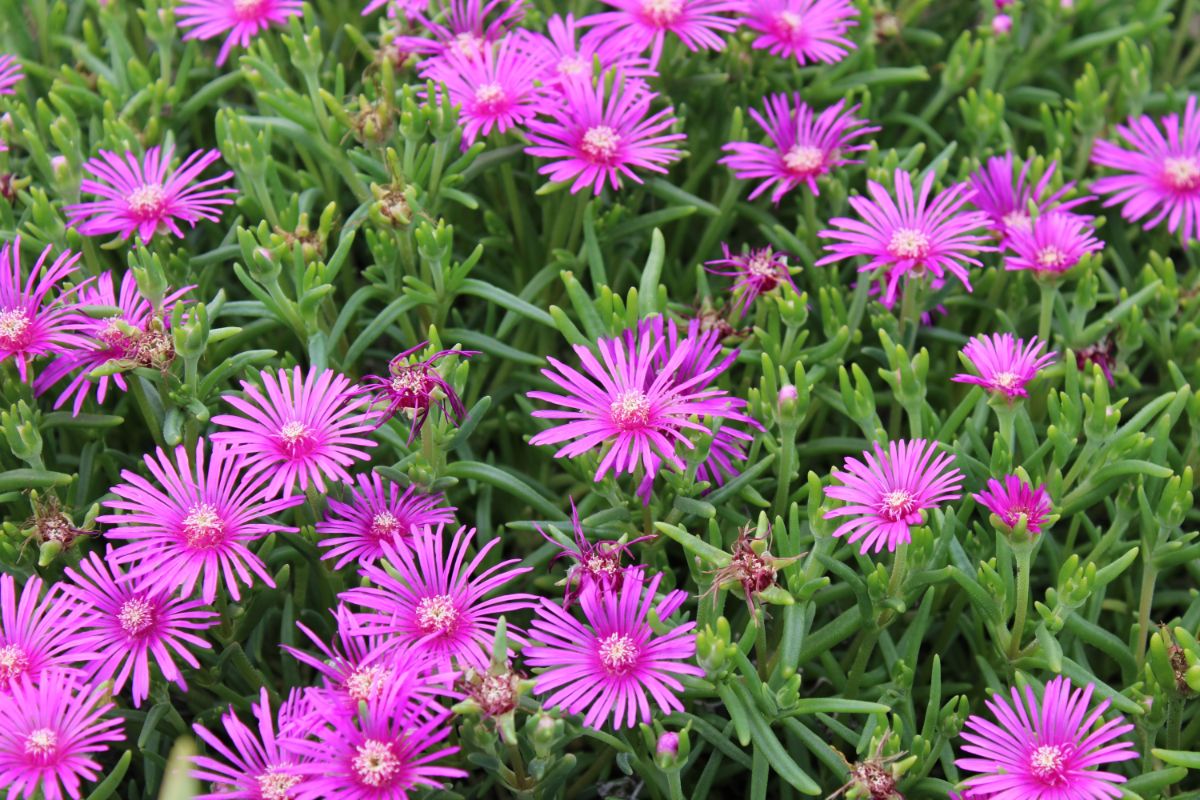
| Plant name: | Ice plant |
| Light needs: | Full sun |
| Water needs: | Moderate to low |
| Growing zone: | Zones 5 to 9 |
| Special features: | Long season blooms; Low water needs |
There are many different plants with the nickname “ice plant,” so it’s a good idea to search for the scientific name on plant labels when searching for this groundcover. Like sedums, ice plants produce succulent leaves that remain evergreen in warm locations, although leaf colors may deepen in cold weather. But more impressively, ice plants also bloom prolifically, and their long-lasting daisy-like flowers can bloom from spring through summer and into early fall.
Like some of the other plants on this list, ice plants can become invasive in some areas, so these plants may not be the best choices for all gardens. When properly cared for, ice plants can double in size in their first year, and mature plants will usually grow to about 6” tall by 24” wide. As with sedums, ice plants grow best in dry and well-draining soil, and they only need to be watered sparingly to keep them happy.
18. Wintercreeper (Euonymus fortunei)
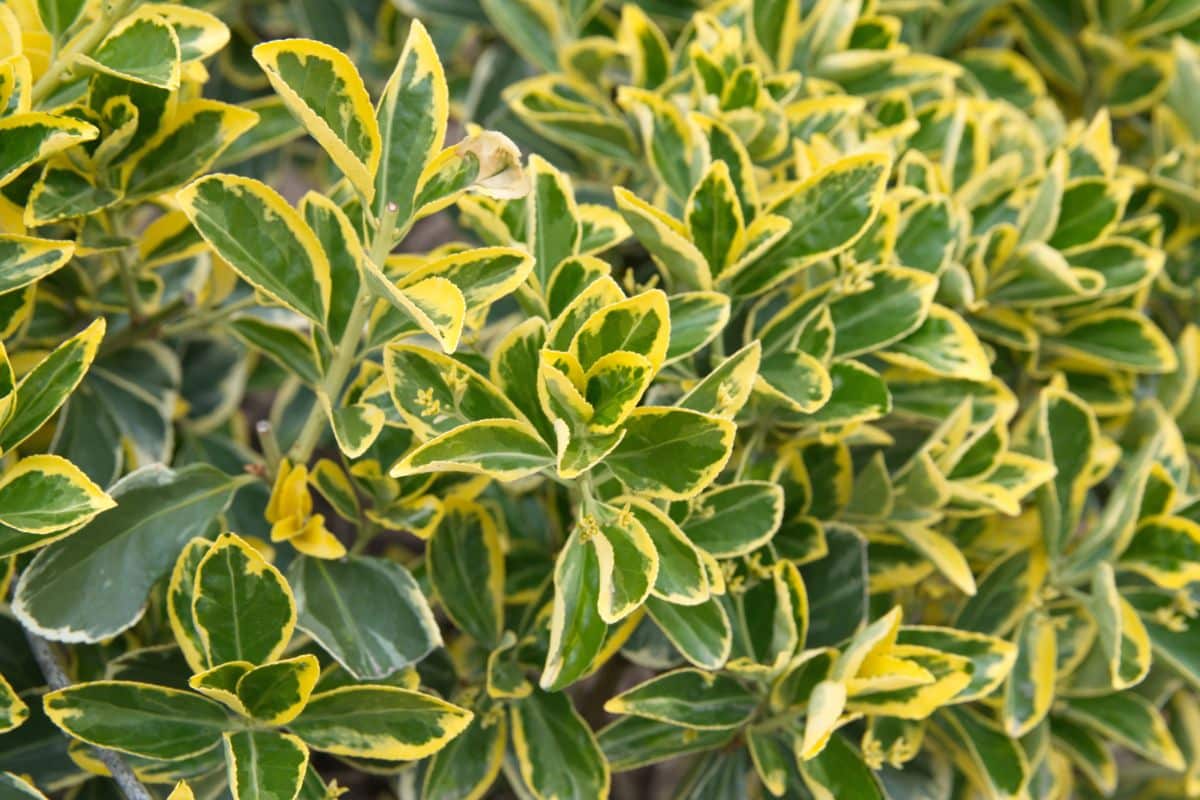
| Plant name: | Wintercreeper |
| Light needs: | Full sun to part shade |
| Water needs: | Moderate to low |
| Growing zone: | Zones 5 to 9 |
| Special features: | Fast growing |
Wintercreeper is native to Asia, and it’s another excellent groundcover choice if you want to make a big impact on weeds. This plant is mostly grown for its showy leaves, although it does produce insignificant, yellow flowers in spring. Wintercreeper can be grown as a climbing plant on trellises, but if you want to keep weeds in line, it also doubles as a groundcover.
A fast-growing plant, wintercreeper can rapidly spread over bare soil, and it can even climb trees if it's allowed to. In some situations, wintercreeper can be invasive, so if you choose to grow it, you will want to keep a careful eye on your plant and prune it back as needed. When mature, wintercreeper vines can spread over 70’ long, although if plants are pruned often, you can keep them under 2 to 4’ wide.
Summary
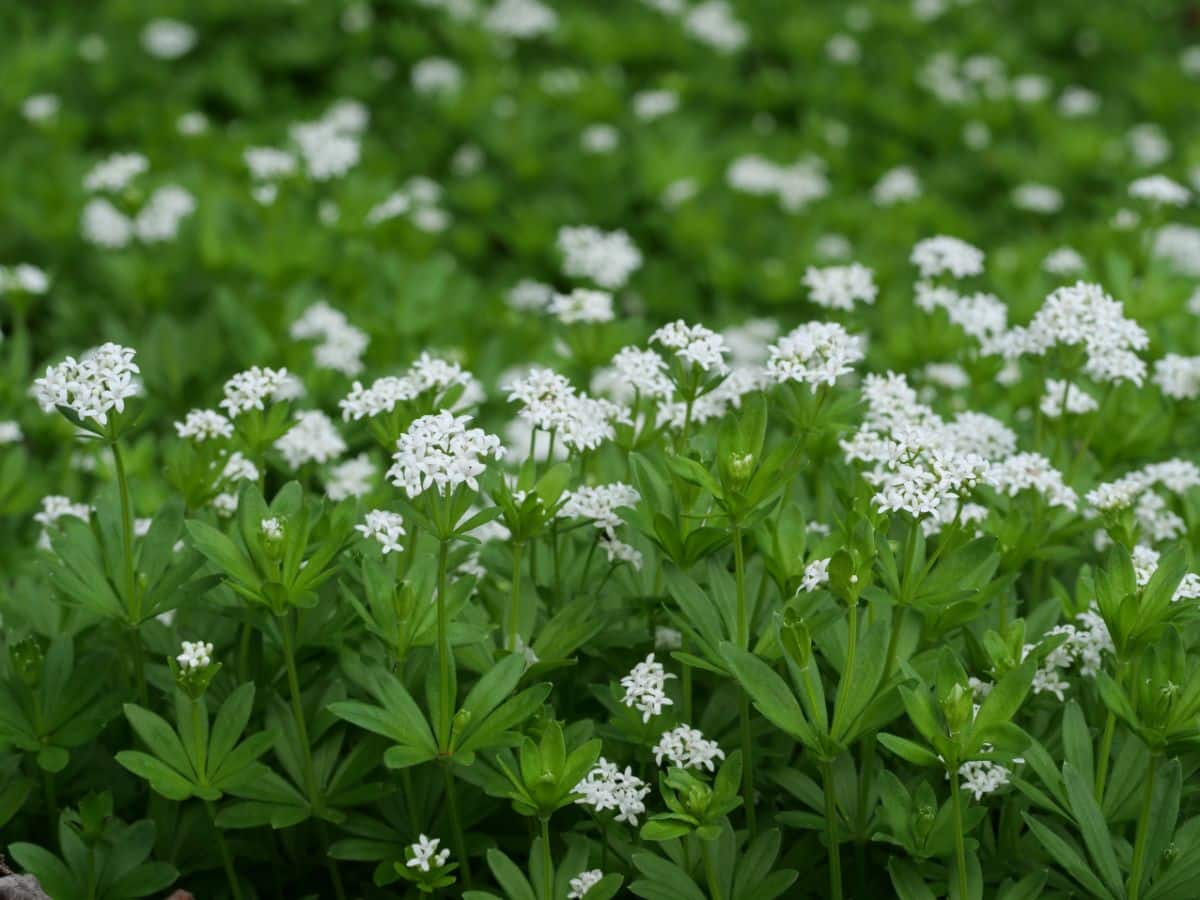
Weeding garden beds regularly is the best way to keep weeds in check. But once you’ve rid your garden of weeds, it’s important to cover up your soil again, or weeds will creep right back in. Mulching is one way to keep weed seeds from sprouting in empty earth, but another option is to cover up your garden with thick layers of natural groundcovers.
Fast-growing groundcovers are ideal for suppressing many types of weeds, but they can also shelter soil from harsh weather and erosion. The plants we’ve covered today all fit the bill and can smother out weeds with ease. But if you’re still hunting for the perfect weed-suppressing plant, you may also want to explore cover crops, which can limit weeds and boost soil health at the same time!

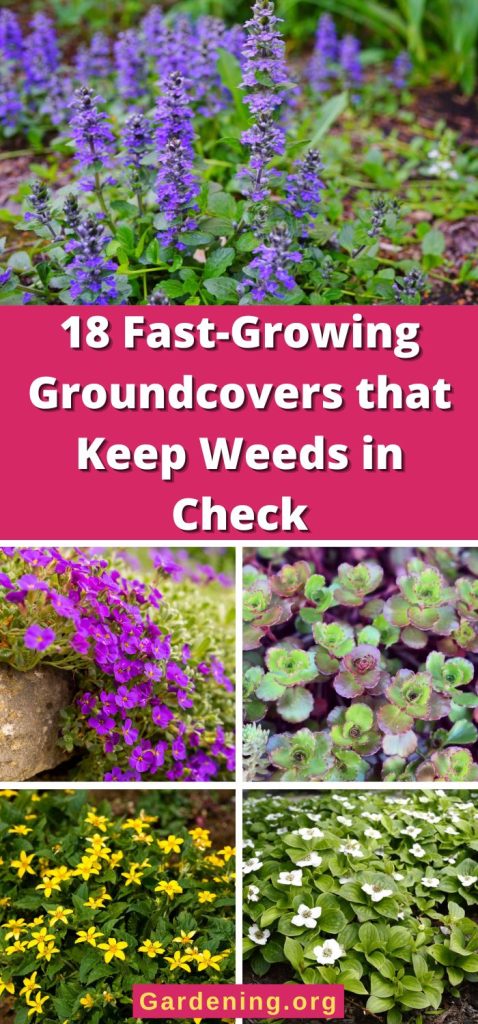
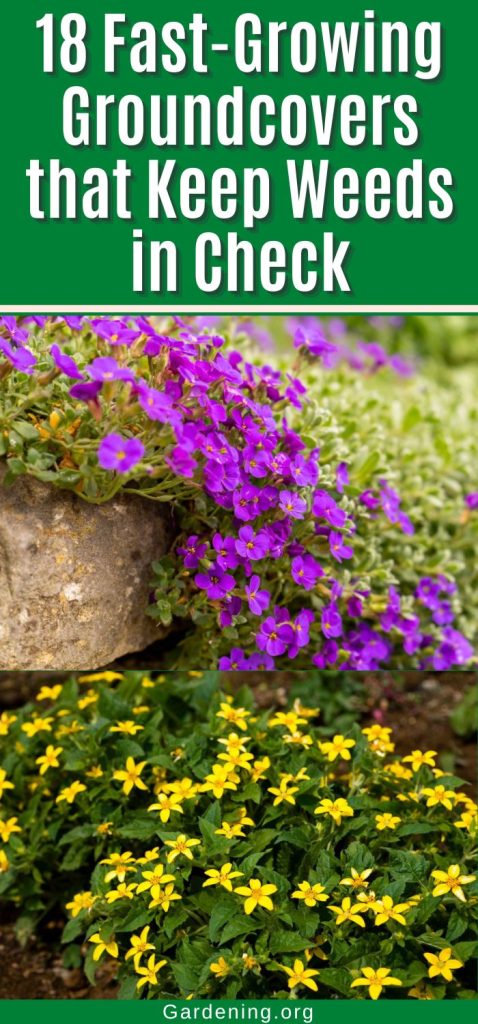
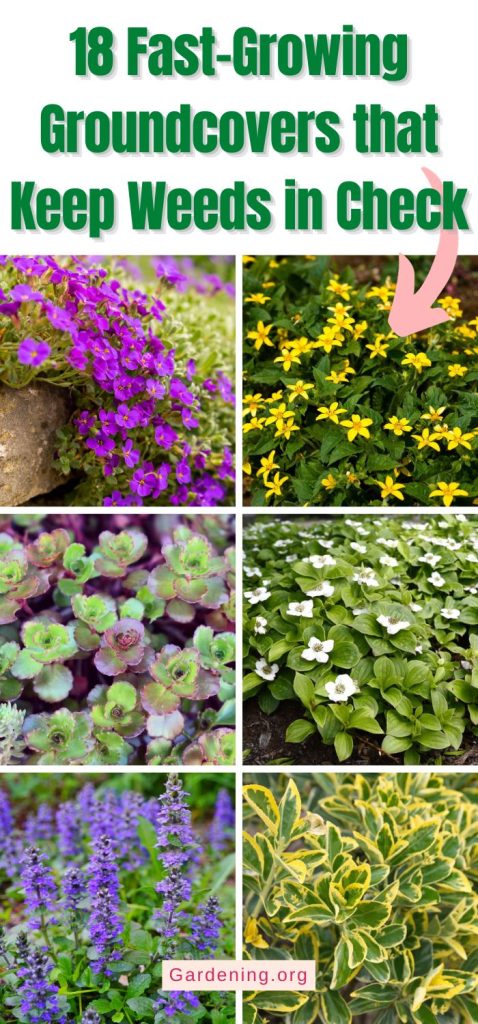
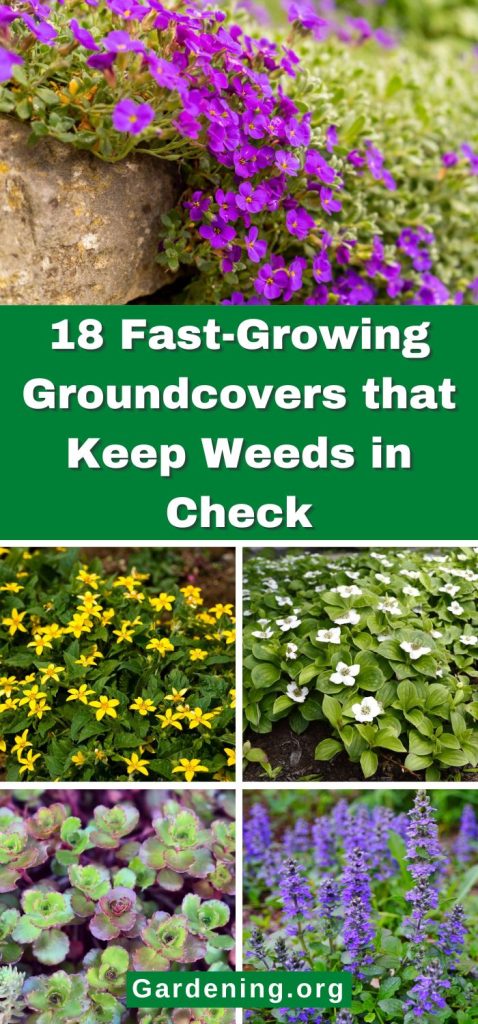
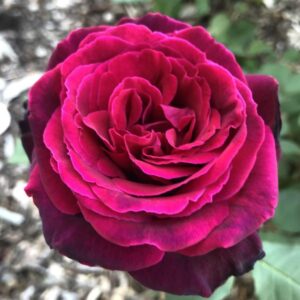
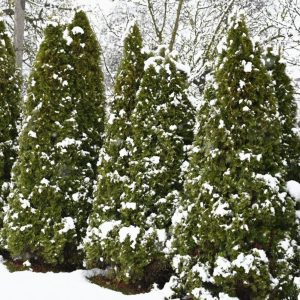


Martin Tichenor
It's a shame I can't see all the valuable content for the constant barrage of annoying pop-ups. SERIOUSLY!?!?
Mary Ward
We understand your frustration and wish there was a better way, but we can't afford to support the site without ad revenue. If you look in the corner, you can X out of many of them.
Patti cherry
I'll second that!!!!
Mary Ward
Again, we do understand but I'm sure you understand that we have to pay the bills, or we couldn't bring you any content at all. :/
Tilman
Thank you. I have the creeping phlox. I planted 4 or 5 2 years ago and it now covers area of approximately 8 x 5 ft. Beautiful pink and purplish blooms. You've given me the knowledge that I have been looking to do ground coverings under some of my trees. Thank you
James
Can I get this article as a PDF file? It is exactly what I have been looking for! Great article.
Juan Castanon
Very good and practical information about the groundcovers.
Krista
Several of these are considered to be invasive in the US and Canada. Shame to be promoting invasive species.
Mary Ward
Invasiveness is very much relative to an area. We always encourage readers to check with their own state or local boards to find out what may be on your invasive list, and avoid plants that are invasive in your location. Just as one man's trash is another man's treasure, one person's invasive plant is another's native or beneficial plant.
Chss
Tooo many ads. Site crashed frequently!!!!!!
Joan
Where do we get these ground covers?
Mary Ward
Check out your local nursery, but many are available through mail order or by ordering online. This depends on where you live, but Fedco Trees, Nourse Farms,Stark Brothers and Eden Brothers are good places to check out, along with others.